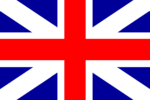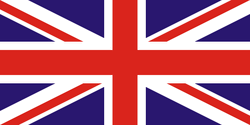With dictionary look up - Double click on any word for its definition.
This section is in advanced English and is only intended to be a guide, not to be taken too seriously!
Contrary to popular belief this is not the national flag of the UK, however the Union Flag or Union Jack is the flag most commonly associated with the United Kingdom of Great Britain and Northern Ireland and was also used throughout the former British Empire. It retains an official or semi-official status in many Commonwealth Realms.
It is commonly referred to as the Union Jack, but Union Flag is actually the correct form as it only becomes a Jack when flown from a ship's jack mast.
The current design of the Union Flag or Jack dates from the union of Ireland and Great Britain in 1801 with the formation of the United Kingdom.
The Court of the Lord Lyon , which has criminal jurisdiction in heraldic matters in Scotland, confirms that the Union Flag "popularly called The Union Jack , is the correct flag for all citizens and corporate bodies of the United Kingdom to fly to demonstrate their loyalty and their nationality."
A careful examination of the flag shows that, contrary to popular belief, the flag does not have reflectional symmetry, but has a right side and a wrong side up. A mnemonic to remind those flying the flag which end is up is Wide white top - the broad white stripe (composing part of the cross of Saint Andrew) should be above the red stripe (the cross of Saint Patrick) in the upper hoist of the flag (the hoist is the half of the flag near the flagpole). Flying the Union Jack upside-down may be regarded as a distress signal.
Terminology: "Union Flag" or "Union Jack"?
The issue of whether it is acceptable to use the term "Union Jack" is one that causes considerable controversy. Although it is often asserted that "Union Jack" should only be used for the flag when it is flown as a jack (a small flag flown at the bow of a ship), it is not universally accepted that the "Jack" of "Union Jack" is a reference to such a jack flag; other explanations have been put forward. See [1] ( https://www.royal.uk/union-jack ) . Even if the term "Union Jack" does derive from the jack flag (as perhaps seems most likely), it has been in use since the early 1700s and, after three centuries, is now sanctioned by usage, has appeared in official usage and remains the popular term.
The term "Union Flag", on the other hand, is indisputably correct and because of this is the term preferred in official documents and by vexillologists (people who study flags).
History
Original Grand Union Flag
 Original Grand Union flag of 1606 .
Original Grand Union flag of 1606 .
When James VI of Scotland also became James I of England in 1603 , the two kingdoms of England and Scotland became united through the institution of the Crown. On April 12, 1606 , a "Grand Union" flag was created to represent this grand union. A proclamation was issued: "All our subjects in this our isle and kingdom of Great Britain and the members thereof, shall bear in their main top the red cross commonly called St George's Cross and the white cross commonly called St. Andrew's Cross joined together according to a form made by our heralds and sent to our Admiral to be published to our said subjects."
The flag was a superposition of the red cross of St George of England and the saltire of St Andrew of Scotland . Note however that the ground of the Grand Union flag is a deep "navy" blue. The blue ground of the Scottish national flag, the saltire, from which the blue ground of the Grand Union flag is derived, is a lighter "royal" blue. The Welsh flag never became part of the Grand Union flag because Wales had been annexed by Edward I of England much earlier and Wales was considered to be a part of the kingdom of England .
The flag became 'the ensign armorial of the United Kingdom of Great Britain' as one of the provisions of the Act of Union on May 1st 1707, when the kingdoms of England and Scotland were officially united.
Current Union Flag
 +
+  =
= 
The current Union Flag dates from 1801 with the 1801 Act of Union with Ireland. The new design added the red saltire cross attributed to St Patrick for Ireland. The saltire is counterchanged to combine it with the saltire of St Andrew. The red cross actually comes from the heraldic device of the Fitzgerald family who were sent by Henry II of England to aid Anglo-Norman rule in Ireland and has rarely been used as an emblem of Ireland by the Irish: a harp, a Celtic cross , a shamrock, or (since 1922) an Irish tricolour have been more common. The St Patrick's saltire flag has been used in more recent times for St Patrick's Day in Northern Ireland, by various organisations wishing to avoid the sectarianism that may be implied by the use of either the tricolour or symbols of Unionism.
The flag is blazoned Azure, the Crosses Saltire of St. Andrew and St. Patrick, quarterly per saltire, counterchanged Argent and Gules, the latter fimbriated of the second, surmounted by the Cross of St. George of the third, fimbriated as the saltire.
Status
The Union Flag is a royal flag, rather than a national flag. In fact, no law has ever been passed making it a national flag, but it has become one through usage. Its first recognition as a national flag came in 1908, when it was stated in Parliament that "the Union Jack should be regarded as the National flag". A more categorical statement was made by the Home Secretary in 1930, when he stated that "the Union Flag is the National Flag". Civilian use is permitted, but stricter guidelines apply for use on naval vessels where the flag may not be used as a jack by merchant ships (see below).
Interesting Links
The Monarchy Today - Lots of further information about the Union Jack/Flag.
History of the Union Flag - A detailed history of the Union Flag.
The United Kingdom - Information on how the UK is organised.
This text is available under the terms of the GNU Free Documentation License.
